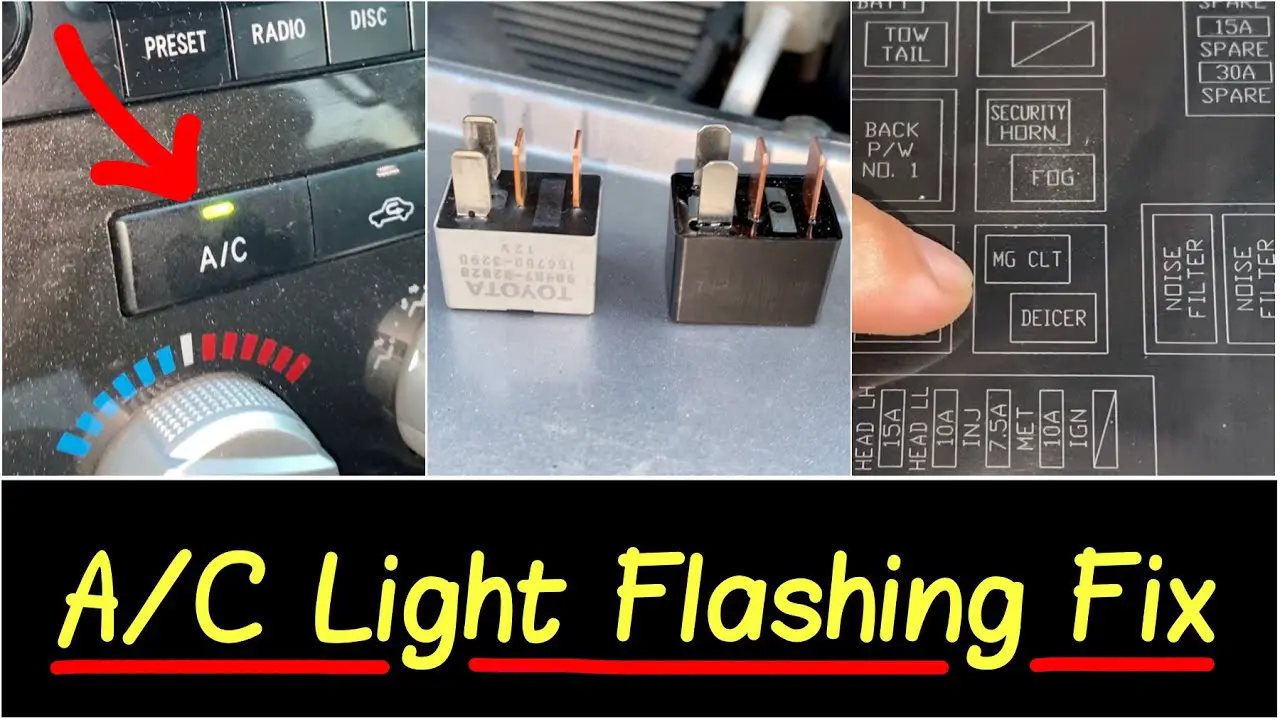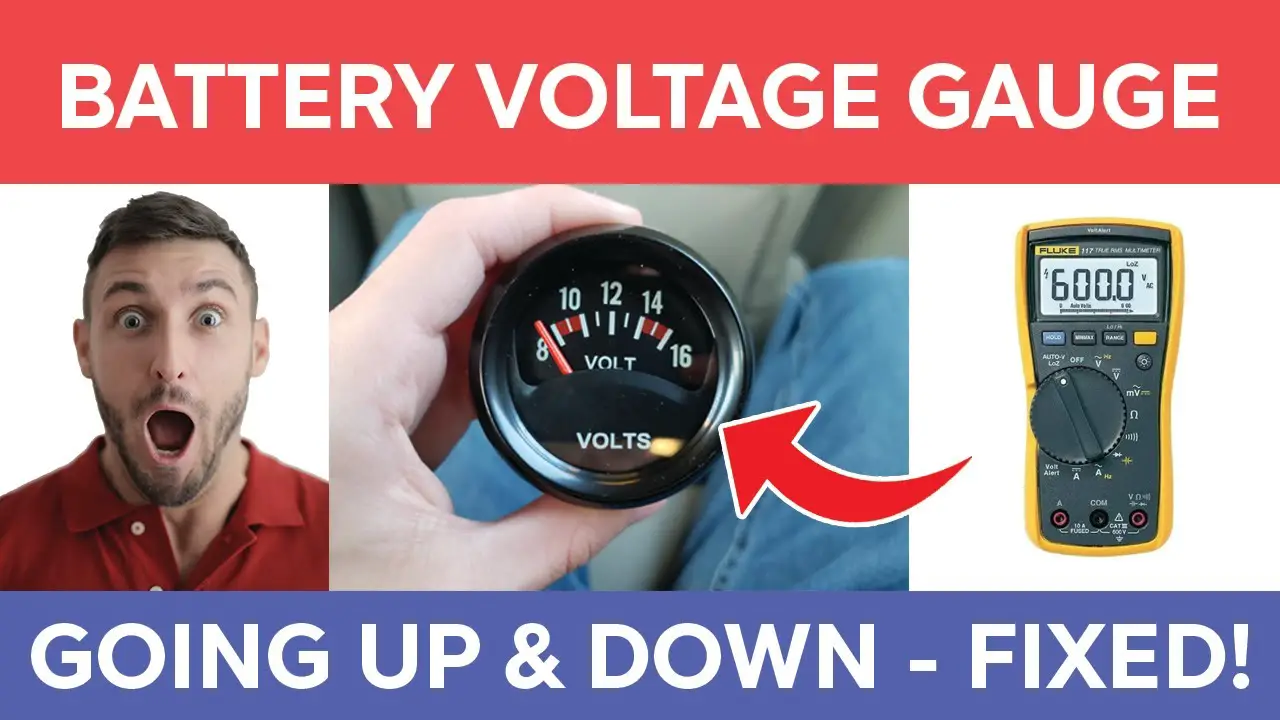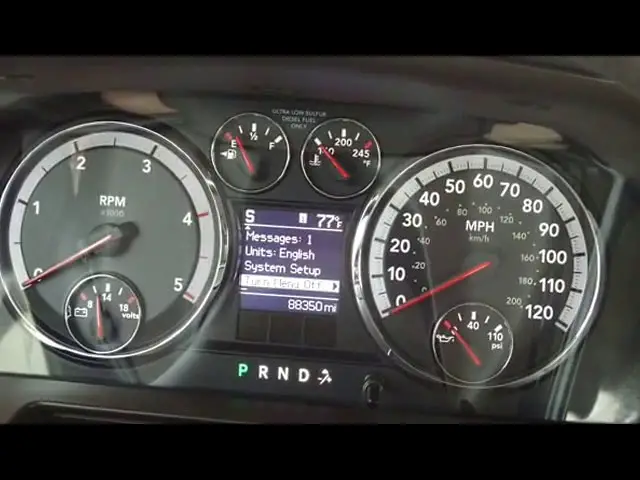If you’re a Toyota Camry owner, you might have noticed the AC light blinking on your dashboard.
This can be a cause for concern, but don’t worry, we’ve got you covered.
In this article, we’ll explore the reasons why the AC light blinks in Toyota Camry models from 2003 to 2014.
We’ll also provide you with some solutions to help you fix the problem.
Whether you own a 2003 Toyota Camry or a 2014 Toyota Camry, this article will help you understand why the AC light is blinking and what you can do to fix it.
So, let’s dive in!
What does it mean when the AC light blinks?
When the AC light blinks in a Toyota Camry, it is an indication that there is a problem with the air conditioning system.
The blinking light could be caused by a variety of issues, such as a malfunctioning compressor clutch, a bad compressor sensor, improper refrigerant charge, or a dirty filter.
The system is programmed to “report” any faults immediately when they are identified by a Toyota Camry AC light flashing.
If you see the AC light blinking, it is advisable to take your car to a professional mechanic or technician for diagnostic problems and repairs.
What Causes AC Light Blinking Toyota Camry?
The blinking AC light in your Toyota Camry is a clear signal that there is a problem within the air conditioning system. Understanding the potential causes for this issue can help you address the problem promptly and avoid more extensive damage. Here are some common reasons why the AC light blinks:
1: Malfunctioning Compressor Clutch
The compressor clutch plays a crucial role in the AC system by engaging and disengaging the compressor. If this component malfunctions, it can lead to a loss of cooling power. When the compressor clutch fails, the refrigerant necessary for proper AC operation is no longer compressed. The blinking AC light serves as a warning to the driver about the issue. Additionally, a malfunctioning compressor clutch may result in damage to the AC compressor due to a lack of lubricating oil, potentially leading to a more expensive repair.
2: Bad Compressor Sensor
The speed sensor in the AC compressor communicates the compressor speed to the air conditioning system. When this sensor fails, it can cause a malfunction in the entire system, leading to a blinking AC light on the dashboard. Several factors can contribute to a broken compressor speed sensor, including debris or dirt accumulation on the sensor or wiring issues. Another potential cause is a failed AC speed sensor, which may occur if the compressor itself fails or if there are issues with other components in the AC system.
2: Improper Refrigerant Charge
Refrigerant is essential for cooling the air within the AC system. If there is insufficient refrigerant or a refrigerant leak, the AC light will blink. Low refrigerant levels prevent the system from adequately cooling the air, triggering the warning light on the dashboard. Checking and maintaining the proper refrigerant charge is crucial for the efficient operation of the AC system.
3: Dirty Filter
A dirty air filter can contribute to the blinking AC light. The filter is responsible for removing impurities from the air passing through the AC system. When the filter is dirty, it forces the AC system to work harder than necessary, potentially causing the light to blink. Regularly changing or cleaning the air filter is a simple yet effective way to ensure the smooth operation of the AC system.
How do I stop my AC from blinking?
Experiencing a blinking AC light in your Toyota Camry can be a frustrating situation, but there are several proactive steps you can take to identify and resolve the issue. Understanding the potential solutions can empower you to address the problem effectively. Here are some recommended steps:
-
Check the Refrigerant Level
Low refrigerant levels are a common culprit for a blinking AC light. Using a pressure gauge, you can assess the refrigerant level in the system. If it is indeed low, adding more refrigerant can restore the proper functioning of the AC system. Ensure that you use the appropriate type and amount of refrigerant as specified in your vehicle’s manual.
-
Replace the Compressor Clutch
A malfunctioning compressor clutch can lead to the blinking AC light. The compressor clutch is vital for engaging and disengaging the compressor, and its failure can result in a loss of cooling power. Consider replacing the compressor clutch to address this issue. This proactive step not only resolves the immediate problem but also helps prevent potential damage to the AC compressor, which could lead to more extensive and costly repairs.
-
Clean or Replace the Filter
A dirty air filter can impede the proper functioning of the AC system and trigger the blinking light. Cleaning or replacing the air filter is a relatively simple yet effective solution. The filter is responsible for removing impurities from the air, and when it becomes clogged, it forces the AC system to work harder. Regular maintenance of the air filter ensures optimal performance and helps prevent future issues.
-
Check the Compressor Sensor
A faulty compressor sensor can contribute to the blinking AC light. Use a multimeter to check the sensor for proper functioning. If the sensor is indeed faulty, replacing it is a recommended solution. Issues with the compressor sensor can disrupt the communication of crucial information about compressor speed to the AC system, leading to malfunctions.
-
Reset the System
Sometimes, a system reset can effectively resolve the problem. Disconnect the car battery for a few minutes and then reconnect it. This action may help reset the AC system and clear any temporary glitches. However, keep in mind that this is a temporary solution, and if the issue persists, further investigation is warranted.
Why is the cool mode blinking on my window AC?
If the cool mode is blinking on your window AC, it could be an indication that the evaporator coils are frosting up or are too cold.
This is signaling that the evaporator temperature is too low and that the compressor may need to cycle off briefly until the evaporator temperature rises.
The primary cause for the evaporator temperature being too low is low outside temperatures while the unit is running.
Typically, this would be an outside temperature below 70 degrees Fahrenheit.
If the outside temperatures are warm and the window air conditioner does not cycle the compressor off but the cool LED indicator light is flashing, service will be needed.
For service, you can schedule a repair appointment with the manufacturer’s service center.
How do I reset my AC compressor On Toyota Camry?

Resetting the AC compressor on a Toyota Camry usually involves disconnecting the car’s battery to clear error codes and reset the system.
Here’s a general guide on how to reset the AC compressor:
-
- Note: Before proceeding, make sure to consult your vehicle’s owner’s manual, as procedures may vary depending on the model year and specific features of your Toyota Camry.
- Turn off the car: Ensure that the ignition is turned off and the key is removed from the ignition.
- Disconnect the battery: Open the hood of your car and locate the battery. Use a wrench or a socket set to disconnect the negative terminal of the battery. Disconnecting the negative terminal is a safety measure to avoid electrical shocks.
- Loosen the nut on the negative terminal.
- Carefully remove the negative (-) cable from the battery.
- Keep in mind that disconnecting the battery may reset other settings in your vehicle, such as radio presets and clock time.
- Wait for a few minutes: Allow the car to sit without the battery connected for at least 5-10 minutes. This will give the car’s computer system enough time to reset.
- Reconnect the battery: After waiting, reconnect the negative terminal of the battery and tighten the nut securely.
- Turn on the ignition: Start your car and turn on the ignition without starting the engine. Let the car run for a few minutes to allow the AC system to recalibrate.
- Check the AC: Turn on the AC system and observe if it is working properly. Adjust the settings and check if the compressor engages.
Also Read: [SOLVED] Why Does Chevy Cruze Key Stuck In Ignition No Power?
If resetting the AC compressor doesn’t resolve the issue, there may be a deeper problem with the AC system that requires professional diagnosis and repair.
In such cases, it is recommended to consult a qualified automotive technician or visit a Toyota service center for assistance.
FAQs
What should I do if the AC light is blinking in my Toyota Camry?
If you see the AC light blinking in your Toyota Camry, it is advisable to take your car to a professional mechanic or technician for diagnostic problems and repairs.
How much does it cost to fix a blinking AC light in a Toyota Camry?
The cost of replacing the AC pressure switch that causes the blinking AC light is between $20 and $100. However, it is important to note that these are just rough estimates and the actual cost could vary depending on the cause of the problem and the extent of the damage. It is best to take your car to a professional mechanic or technician for diagnostic problems and repairs.
What is the average lifespan of a Toyota Camry air conditioning system?
The average lifespan of a Toyota Camry air conditioning system is around 10-15 years.
How often should I service my Toyota Camry air conditioning system?
It is recommended to service your Toyota Camry air conditioning system every 2 years or 24,000 miles.
What is the best way to maintain my Toyota Camry air conditioning system?
The best way to maintain your Toyota Camry air conditioning system is to have it serviced regularly, keep the filter clean, and ensure that the refrigerant level is correct.
Can I drive my Toyota Camry with a blinking AC light?
It is not advisable to drive your Toyota Camry with a blinking AC light. It is best to take your car to a professional mechanic or technician for diagnostic problems and repairs.
What is the average cost of replacing a Toyota Camry air conditioning system?
The average cost of replacing a Toyota Camry air conditioning system is around $1,000-$2,000.
How long does it take to replace a Toyota Camry air conditioning system?
The time it takes to replace a Toyota Camry air conditioning system depends on the cause of the problem and the extent of the damage.
What is the best way to prevent the AC light from blinking in my Toyota Camry?
The best way to prevent the AC light from blinking in your Toyota Camry is to have it serviced regularly, keep the filter clean, and ensure that the refrigerant level is correct.
What is the most common cause of a dirty filter in a Toyota Camry air conditioning system?
The most common cause of a dirty filter in a Toyota Camry air conditioning system is a lack of maintenance.
How do I know if my Toyota Camry air conditioning system needs to be serviced?
If you notice that your Toyota Camry air conditioning system is not working properly, such as blowing hot air instead of cold air, it is advisable to take your car to a professional mechanic or technician for diagnostic problems and repairs.
Conclusion
We hope this article has been helpful in providing you with a better understanding of why the AC light blinks in Toyota Camry models from 2003 to 2014.
As we have discussed, there are several reasons why the AC light blinks, including a malfunctioning compressor clutch, a bad compressor sensor, improper refrigerant charge, or a dirty filter.
We have also provided you with some solutions to help you fix the problem, such as checking the refrigerant level, replacing the compressor clutch, cleaning or replacing the filter, checking the compressor sensor, and resetting the system.
Remember, if you’re experiencing a blinking AC light in your Toyota Camry, it is advisable to take your car to a professional mechanic or technician for diagnostic problems and repairs.
Thank you for reading!




